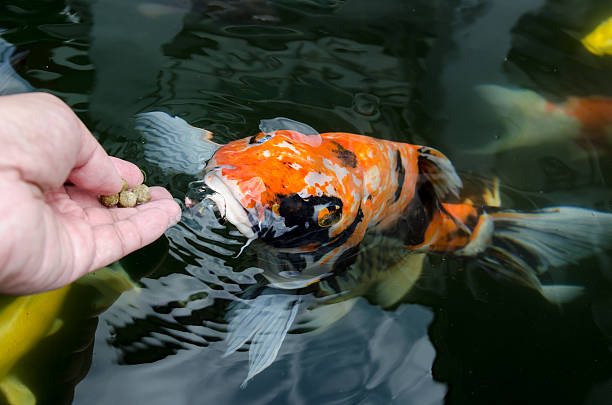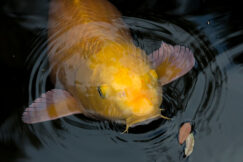Koi are stunning fish that are popular among both beginners and experts alike.
Koi are readily identifiable because of their popularity and beautiful colors. However, given the beauty of the ponds and aquascaping required, koi maintenance may appear complicated.
However, they have fundamental prerequisites that any well-educated pond keeper may meet.
If you decide whether to purchase, recently purchased a koi, or if you’ve had one for years, this helpful guide will teach you everything you need to know about caring for your Koi. From understanding their needs to feeding them to breeding them, Koi Fish Care is your ultimate resource for keeping your fish happy and healthy.
Overview of Koi Fish Care
So, what precisely is Koi? The Amur Carp (Cyprinus rubrofuscus), an Asian cyprinid related to goldfish, barbs, and danios, is an ornamental variant of the Amur Carp (Cyprinus rubrofuscus).
Koi were developed in Japan in the nineteenth century as an alternative to the Chinese custom of keeping beautiful goldfish (Carassius auratus). The term “koi” is an anglicized version of their Japanese name, “Nishikigoi.”
Before being grown for color, Nishikigoi was mostly kept as food fish because they reproduce easily in ponds and are hardy enough to overwinter in the country’s coldest regions. Then, people gradually began separating variations with hues that deviated from the muddy brown wild-type carp.
Koi are available in hundreds of types defined and recognized by Japanese and international organizations that categorize them based on color, pattern, and scale type. All of them, however, are cold-water fish that may be housed in both outdoor ponds and indoor aquariums!
The primary requirements of Koi are room and clean water. Although Koi are tolerant to high ammonia, nitrite, and nitrate levels, they should never be maintained indefinitely in these circumstances.
Fortunately, a high-quality canister or pond filter combined with live plants allows you to offer circumstances near 0 ppm, which all fish appreciate! However, what about living quarters? Koi prefer ponds or aquariums.
Is it hard to care for koi fish?
Koi fish are resilient, making them extremely easy to care for. However, they might develop various health problems if the water quality is not maintained properly. As a result, as a Koi owner, you must manage specific water quality parameters, such as pH fluctuation caused by acid rain or low potassium hydride, high ammonia and nitrite owing to excessive fish waste, overpopulation, and so on.
To keep your Koi healthy, you must maintain proper water conditions. Maintain a low ammonia level, a pH level of 7-8.5, and a minimum amount of oxygen of 6mg/liter. In addition, check for iron, chlorine, lead, zinc, or copper in the pond.
You may also preserve your pond water with a high mineral content, which will assist you in avoiding the harmful chemicals dissolving in their environment. Fulfilling these conditions will guarantee that your koi pond has a good water habitat.
Is Koi Fish Expensive to Keep?
Although caring for Koi fish is not difficult, it might be particularly difficult if you cannot pick them up. They may appear graceful, gorgeous, and colorful, but they are quite untidy since they create a lot of excrement, which may quickly render the pond water murky. As a result, you must keep the water clean and well-balanced in terms of oxygen and other components so that they may thrive through all seasons.
What You Should Know About Your Koi
- Koi may grow to be 36 inches (91 cm) long and
- The average life of a koi fish is 25 – 35 years in various water conditions.
- They are normally calm. However, they may prey on slower-moving fish.
- They are a variety of carp that is endemic to Japan.
- Koi may learn to identify and accept food from their caretakers.
Common Behavior of a koi fish

Koi are relatively calm fish that will engage with those in their school while leaving that outside alone.
They form schools of 5 to 15 individuals and will swim in wonderfully synchronized patterns.
Koi will visit every level of your pond. They will dart and swim along the surface and intermediate levels, foraging for natural meals at the bottom.
In colder weather, they will seek refuge in the deeper layers of your pond.
They are very energetic and free-swimming fish that will display their vivid colors at any chance.
Koi fish have an unusual method of seeking food.
They will dig and burrow into the dirt to uproot plants and eat edible seeds while foraging.
They consume like a vacuum cleaner, sucking in large gulps of food and sifting away dirt and muck.
This peculiar feeding method makes them a significant problem in freshwater settings.
Types of Koi fish
Koi fish may grow 3 feet long, making them one of the biggest cyprinids and one of the largest fish usually kept in home ponds.
They typically have two barbels on each side of the mouth, a round snout, and a toothless jaw for gulping down prey.
Females are bigger and rounder in shape than men. Their fins are typically small and rounded, with lobed caudal fins. On the other hand, certain types are bred for their lengthy trailing fins.
These stunning fish come in a variety of vibrant hues. They are usually white or silver in appearance, with iridescent scales and bright spots and patterns.
These marks might be red, gold, orange, black, or deep blue.
Their precise hue and markings vary according to the kind.
Butterfly Koi Fish
Butterfly Koi (also known as Dragon Koi) are so-called because of their long pectoral and caudal fins.
They are highly sought after and treasured by keepers.
This species can be found in any of the normal color variants and is distinguished solely by the length of its fins.
Japanese Koi Fish
These are the most popular kind of Koi seen in ponds and water gardens.
White with orange/red patterns, Kohaku Japanese Koi are Japanese Koi. They are regarded as the standard variety.
Tancho Koi are Kohaku Koi with a single red spot on their heads.
The Dragon Koi Fish
The dragon can refer to two types of Koi. Most of the time, it’s just another name for the Butterfly Koi.
A Dragon Fish is another name for the Kumonryu variation. This is a black and white fish whose markings vary with the seasons.
Black and White Koi Fish
Shiro Utsui fish are white with black patterns and dots. Some feature a split-head design, with white on one side and black on the other.
Matsuba Koi can be black and white, but they can also have black markings on a red or gold background.
Gold Koi Fish
Ogon is a highly sought-after one-color cultivar. An Ogon fish is completely silver, orange, or gold in color.
Ki is typical Koi with gold patterns on white bodies. Kinrin fish have stunning scales that shimmer like gold coins.
Aquariums and Koi Ponds?
One of the most crucial factors is the habitat where you will keep your Koi. There is, of course, the iconic koi pond, but an aquarium or tank is also a possibility in some cases.
Each of these solutions has advantages and disadvantages.
Keeping Koi in Aquariums at Home
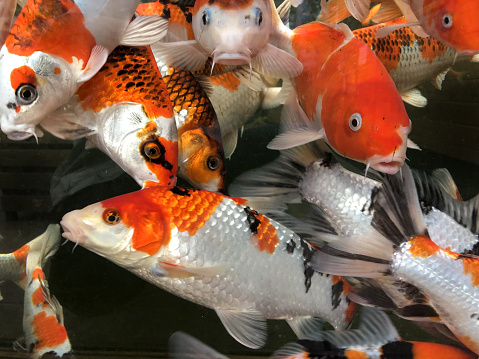
So, what’s the difference between keeping Koi in a home aquarium and a pond? The key reasons are the simplicity and quickness with which an aquarium may be put up and the reduced cost. On the other hand, outdoor ponds are more expensive, involve more planning, and take up far more room than a home aquarium. Or, perhaps, an outside pond is not an option where you live.
However, Koi are only suitable for aquarium tanks when they are young. A fully grown koi may grow to be nearly 3 feet long, implying that you’ll need to relocate them to an indoor or outdoor pond at some time. However, they outgrow aquariums with time, letting you keep them in a more convenient environment for a longer period.
Keeping Koi indoors also eliminates the need to deal with overwintering them, necessitating additional technology and feeding a wheat germ-based winter diet as the days become shorter. You may enjoy your Koi all year instead of only from mid-spring until October.
The only major negative is that you will eventually have to transition to a pond or rehome your Koi. When you maintain Koi in an aquarium, you are effectively postponing the inevitable.
How can I set up an aquarium for my Koi?
- Koi develop swiftly and can reach enormous sizes. Keep adult koi in a 3-foot-deep outdoor pond with at least 50 gallons of water per fish.
- Young Koi can be housed inside an aquarium with at least 29 gallons capacity.
- Place the aquarium in a quiet location away from direct sunlight and drafts.
- Cover the aquarium with a cowl to prevent fish from jumping out and to avoid evaporation and splashing.
- When transferring fresh Koi to the aquarium, float them in the water within their bag for around 10 minutes to acclimatize them to the new water temperature.
- If you’re adding Koi to an established school in an aquarium or pond, quarantine the new fish for 2 to 4 weeks in a different body of water to ensure their health.
- On moving day, use a net to transport the Koi so that old and new water do not mix.
- Add no more than three new Koi at a time, whether they dwell indoors or outdoors.
Maintaining Koi in Outdoor Ponds
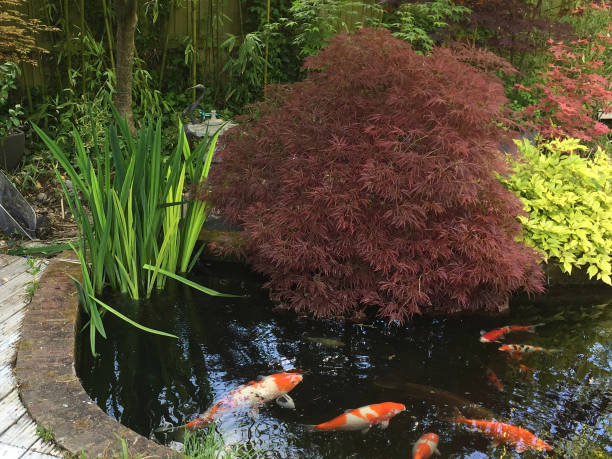
Even if you live in a colder region of the world, as a koi keeper, you have the choice of keeping your carp in an outdoor pond all year.
Koi are native to Japan, a temperate region with harsh winters that cause ponds to ice over.
Koi have the potential to hibernate throughout the winter, reducing their metabolic processes to the point where they don’t need to feed for months and use very little oxygen.
This necessitates using a pond de-icer to maintain a hole in the ice open for proper gas exchange. However, following the plan, your Koi will be hungry and active as the ice melts and spring arrives.
Koi also makes an excellent outside focus piece for your gardening. When combined with waterfalls, statues, and other features, it’s difficult to top a koi pond for creativity and a place to relax!
Finally, Koi can never outgrow a properly sized outdoor pond. When I say “appropriately sized,” I mean a pond deep enough for them to overwinter and long enough to live happily as adults.
3 feet is a desirable minimum depth for a koi pond, with 4 feet being preferable in areas where the pond is certain to freeze over. Because Koi prefer moderate circumstances, they do not like being maintained in shallow water in hot summer climates.
The sun may raise the temperature of shallow ponds to dangerously high levels and reduce the dissolved oxygen concentration to the point that your fish gasp for the surface. Otherwise, your Koi will spend most of their time in the cooler, well-oxygenated, deeper parts of the pond until it’s time to feed!
The primary disadvantage of maintaining Koi in outdoor ponds is the required preparation and money.
Ponds just require more time and work to construct. But, of course, once completed, you’ll have a one-of-a-kind water feature that will last you for decades. However, an aquarium is both faster and less expensive. Just keep in mind that your Koi will eventually outgrow any tank.
Outdoor Predators And Koi

Predators on the Ground
Another disadvantage of keeping Koi outside is that they are always vulnerable to predators in the area. Once free-roaming cats, raccoons, and minks learn your pond is full of plump fish that can’t leave, they may become regular visitors. While they are abundant in urban and suburban areas throughout the United States, they are also the easiest predators to deal with.
Cats and raccoons both need a perch to get to your fish. Raccoons, in particular, are waders rather than swimmers. They prefer ponds with shallow shelves because they can stroll around the edges, hoping to snag a koi. On the other hand, a pond with a deep ledge will keep them away from your fish.
Other ground predators, such as minks, can swim and may require a more powerful deterrent, such as an electric fence. This does not have to be a high fence like those found in horse pastures. Instead, they can be as few wires suspended less than a foot over the ground.
Bird Predators
Herons, egrets, and other predatory birds pose a greater threat to outdoor ponds due to their long legs, which allow them to remain unimpeded in a few feet of water. In addition, they can fly, making it difficult to keep them out of your yard. And they prefer to hunt around dawn or dusk since the light levels are low, and they have a better chance of catching fish before they become apparent.
These are also the hours when you are least likely to be out enjoying your pond. If you don’t have a shelf where raccoons may hunt but notice fish disappearing regularly, a hungry heron is probably visiting you for breakfast or a late meal.
When it comes to herons and egrets, there are two major approaches. First, cover your pond with mesh netting when you are not present. In this manner, the birds won’t be able to get to your fish or land in the pond. The disadvantage of this strategy is that it does not look attractive, but it is completely foolproof.
The second method is to employ a plastic decoy to trick the birds into believing the pond is already inhabited! Owls and hawks are hazardous predators to most birds, and placing an owl decoy nearby will typically entice a heron investigating the area to leave. Herons and egrets are likewise quite territorial; putting a decoy heron or egret in the pond typically has the same effect.
Finally, you may employ a floating alligator decoy to scare the birds away! Remember to change the decoys every few days, or the birds will learn to disregard them.
Even the most determined heron or egret will not be able to swallow a fully developed koi. However, they may try to steal one nevertheless, and their spear-like beaks can leave ragged wounds that never heal completely. So keep an eye out for outdoor koi predators!
How many gallons does a koi require?
Once you’ve settled on a koi pond or aquarium, you’ll need to figure out how big it needs to be.
So, how many gallons do we require for each Koi? On the surface, this appears to be a straightforward question, but it is far more involved. Pond design, water flow rate, oxygen levels, filtration system, aquatic vegetation, and frequency of water changes are all important considerations.
There are a few general guidelines that are a good place to start. The first rule of thumb is one inch of fish per ten gallons of water. So, for example, a 16-inch koi would require 160 liters of water.
This is the total number of inches of fish in the water guideline. So, if you had four 16-inch fish, you would multiply four by sixteen to get 64 inches, which would require 640 gallons of water.
Remember that this is the minimum and that more water is typically preferable. It’s also worth noting that Koi develop quickly. So your 6-inch Koi will soon grow 12 inches, eventually 24 inches! So when evaluating water volume requirements, keep this growth potential in mind.
One fish every 250 gallons or four per 1000 gallons is a more liberal rule of thumb. This factor considers a koi’s ability to develop to a length of 24 inches.
Water Filtration and Quality

Filtration of water
But you’ll need more than just space to keep your fish healthy for years. You’ll need to be able to evaluate and maintain excellent koi water conditions.
Fortunately, it is now simpler than ever to guarantee that the three principal pollutants in aquatic environments, ammonia, nitrite, and nitrates, are adequately regulated!
A filter of some form is used in almost all pond designs. And the majority of pond filters rely on a plastic or metal box that is either affixed to the pond’s edge or submerged beneath. A pump then drives water into the filtration unit, passing through various physical and chemical media before being returned to the pond.
A developed filter can handle the nitrogenous wastes that fish produce. And the biological filtering component is critical. Biological filtration entails collaborating with helpful bacteria that feed on ammonia, converting it to nitrite, which is less poisonous but still not ideal for fish.
Fortunately, the second group of bacteria consumes nitrite and converts it to nitrate, which is less hazardous. While these bacteria may be found throughout the water column and substrate, a suitable filter provides a breeding ground for them. Pond plants also benefit your biological filtration system since they use all three substances as fertilizer.
Water Quality Testing
Monitoring your water quality is vital because unexpected changes might be fatal to your fish. Water test kits allow you to check the pH, ammonia, nitrate, hardness, and other factors to verify they are within tolerable limits.
Fortunately, Koi are not picky about pH, preferring a range of mildly acidic to moderately alkaline (pH 6.5-8.0). They are likewise indifferent to hardness levels (dissolved minerals) as long as extremes are avoided.
Ammonia and other nitrogenous wastes should be your first focus, followed by the temperature of your aquarium or pond, making a thermometer an indispensable instrument.
The temperature of the water
Koi are extremely climate tolerant and may even hibernate under the ice in the winter. Make sure your pond is at least three feet deep—otherwise, it may freeze solid, and Koi aren’t all that strong. Koi love chilly water—between 65 and 75 degrees Fahrenheit—when they reside inside (18 to 24 C).
Do Koi Pond Require Sunlight or Shade?
Koi fish, in particular, demand ponds with a specified temperature range. However, the fish will suffer undue stress because the pond water is excessively hot. Choose a pond that is somewhat covered throughout the day and receives a few hours of shade daily to produce an optimum climate for your Koi fish.
- Outdoor Koi are robust and will hibernate under the ice in the winter if their pond is deep enough not to freeze. (They will perish in solid ice.)
- The pond for your Koi should be somewhat shaded.
- Indoor Koi enjoy water temperatures ranging from 65 to 75 degrees Fahrenheit.
- Install a light inside an indoor aquarium to keep it illuminated for 8 to 12 hours daily.
Do Koi Fish Require Lighting at Night?
No, you do not need to leave your light on at night for the Koi because it does not affect their sleeping habits. You may, however, employ artificial lighting to observe the depths of your pond.
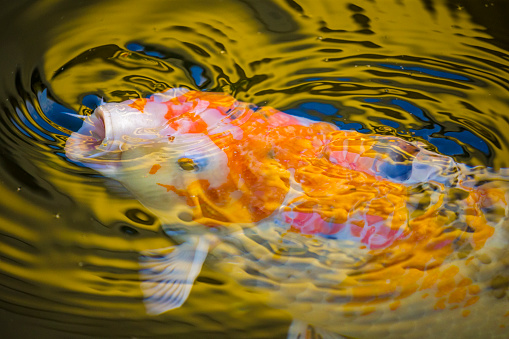
Stress And Disease Diagnosis
Prevention is always the best treatment for keeping any pet healthy. However, things happen, and you may need to diagnose and treat an ailment. So what are some of the most prevalent koi illnesses to be aware of?
Gasping
Koi gasping at the surface indicates a low dissolved oxygen concentration; the water near the surface has the most oxygen. Therefore your fish are sticking there, attempting to breathe.
The causes are several; the most prevalent is insufficient circulation in your pond or aquarium, which necessitates the purchase of an aeration stone or power head.
Warm temperatures can also be a problem since the warmer the water, the less dissolved oxygen it can carry. High nitrate levels are another potential; nitrate may build up in fish blood, interfering with their capacity to exchange CO2 for oxygen and coloring their gills brown when examined closely. This indicates that you must replace your water or your filter isn’t operating properly.
Excessive Mucus or Cloudy Eyes
Excess mucus or cloudiness in the eyes are classic indications of a bacterial infection in the eyes or skin. The manufacturer’s recommendations should use broad-spectrum antibiotics, such as Melafix. Excess mucus, along with shimmying motions or scraping up against rocks and other decorations, might also suggest the presence of parasites or irritating compounds in the water.
Lesions or Abrasions
Wounds should be treated with extreme caution; if possible, move a koi with an open wound to a hospital tank or small pond for monitoring. Rips along their flanks are likely the result of a predator, such as a heron, attempting but failing to grab your fish.
Red and inflamed sores are nearly the consequence of a bacterial or fungal infection requiring treatment. You should also check your water for excessive ammonia, nitrites, and nitrates since these chemicals suppress the immune system and make Koi more susceptible to diseases.
Appetite Loss
If you see one or more Koi that aren’t interested in food, examine the time of year. The chilly weather of early spring and late fall lowers their metabolisms to the point that they may not be hungry!
However, if you’re not nearing hibernation, it’s conceivable that they have inside parasites, especially if you notice a significant weight reduction. Intestinal worms are a persistent threat to outdoor pets, but they are also very straightforward to cure with drugs such as Prazipro.
Nutrition and Feeding of Koi
Feeding your Koi is one of the most enjoyable aspects of raising these fish! The excitement they exude as they compete for pellets and splash around is thrilling! So let’s speak about koi feeding habits and what kind of food to provide them.
Koi are omnivorous by nature. That is, they consume both plant and animal stuff. Algae, delicate aquatic plants such as Cabomba and Elodea, worms, tiny snails, and anything else they encounter are all promptly consumed.
As a result, we want to provide them with a broad diet that supports excellent health and spawning behavior once they reach maturity.
When shopping for koi food, I usually recommend reading the ingredients carefully. Animal proteins, such as shrimp meal or insect larvae, are excellent building blocks, such as plant additions such as spirulina.
Most koi formulae employ wheat germ, potato starch, and other plant-based substances, which is good if the nutritional profile is balanced with additional ingredients.
Vitamin and amino acid supplements are also beneficial, as are taste enhancers such as garlic or rosemary oil (perfect for picky or sick fish that are unwilling to feed).
Color enhancers such as beta-carotene, astaxanthin, and canthaxanthin are also excellent additions to search for. These are pigments that occur naturally in krill and other vividly colored foods. They can build up in your Koi when consumed, intensifying their red, orange, and yellow tones.
Don’t forget to switch up your mixes as fall and winter approach. Because their metabolisms slow down when the water temperature drops, they will require more readily digestible formulae, normally comprised primarily of wheat germ.
The intricacy of the regular koi diet during this phase leads it to sit in the digestive tract for an extended time. It can even decay there, causing intestinal bloating and death.
Breeding
Breeding Koi fish will necessitate using a separate pond for mating and spawning.
It can be done spontaneously or artificially, such as via hormone injections. The fish will attain sexual maturity between 2 and 5 years old, and natural breeding will occur in the spring.
There should be 2-3 males for every female in a breeding pond. This is because the best spawners are larger, older females.
Keep your breeding pond at temperatures ranging from 64 to 72°F to promote natural breeding circumstances.
They should be fed high-protein diets, including natural and commercial foods, up to three times daily.
Females will deposit their eggs in your shallow-water plants, and the male will fertilize them when they hatch. This type of external fertilization occurs in a wide range of fish species.
Once fertilized, the eggs must be retrieved and put in an incubation tank. They will hatch in three to four days.
Your baby fish will not be very attractive. They are quite little as larvae and will drift through the water like zooplankton.
They will resemble very little scale-less fish as they reach the fry stage and lose their yolk sacs.
Fry may be raised inside a tank until they reach the juvenile stage. Then, they should be fed brine shrimp larvae and hard-boiled eggs mixed with water.
They will resemble smaller replicas of adult fish once they reach the juvenile stage. They can then be placed in the pond and fed the same meals as adults.
Companions for Koi Fish
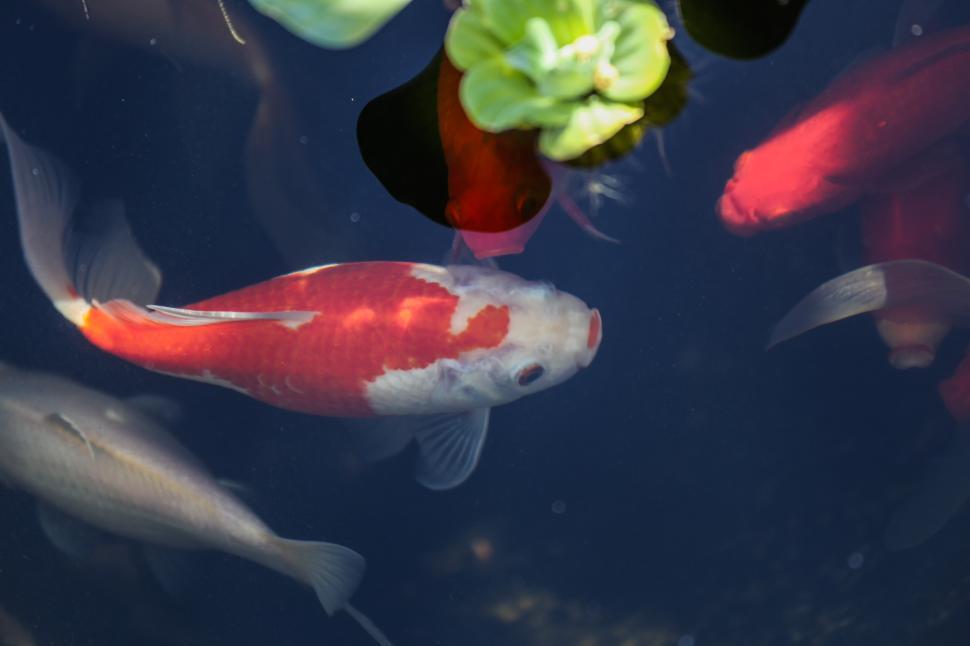
Koi are remarkably quiet, social fish who disregard the bulk of their tank and pond companions despite their size. However, smaller fish are likely to be startled by a school of huge Koi; therefore, larger fish make excellent companions. And fish that live in temperate climates are preferred, which means that most tropical aquarium fish are out of the question. Fortunately, there are still a lot of options!
Goldfish & Other Cyprinids
Goldfish and Koi go together like clockwork. While smaller, goldfish, such as the calico shubunkin, exist in various color variants that Koi do not, offering different colors and contrast to your setting. They eat the same meals as adult koi. Therefore they don’t need any particular care. They will even go to school with Koi with no reservations!
Other cyprinids aren’t as abundant, but the Chinese Hi Fin Banded Shark is one to watch (Myxocyprinus asiaticus). This distant cousin can only be found in the Yangtze River in Central China. When they are young, they have attractive chocolate and pink banded pattern, a slumped back, and a shark-like dorsal fin.
They become pretty bland-looking fish as they age, and at 4 feet long, they can outgrow Koi! Fortunately, they are calm algae eaters that will consume the same pellets as Koi to augment their diet!
Another example is the Common Tench (Tinca tinca), an Asiatic cyprinid with food and care requirements similar to Koi. Tench are also available in a gorgeous gold morph that may be seen at aquarium and pond retailers on occasion. As adults, they grow to a considerably more manageable 2 feet in length and are tranquil bottom dwellers.
Apple Snails

The majority of snails will end up as a pleasant feast for Koi. After swallowing snail shells, Koi utilize their pharyngeal (throat) teeth to crush them. You could try some of the larger varieties; fully grown apple snails are too enormous for any but the largest fish to consume. However, the majority of the other snails will undoubtedly be eaten.
However, you can take advantage of this, especially with fast-breeding snails like ramshorn snails. Your Koi will almost certainly never be able to consume them all. Snails also consume debris, algae, and other biofilm and trash that collect on the bottom of your aquarium or pond, assisting in cleaning your aquarium or pond!
Turtles
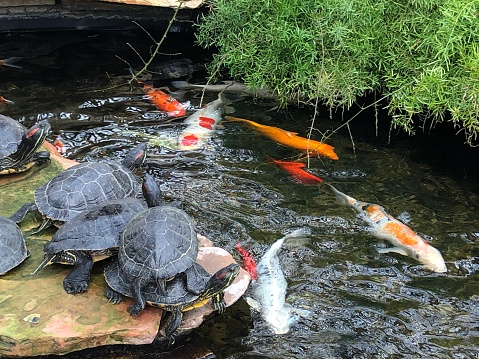
Turtles are popular pond dwellers, but they should be kept apart from any type of fish. They are opportunistic and will snap at almost anything if they believe they can eat it. If a turtle approaches too close, even a huge koi may find a part of its tail gone.
The easiest approach to cope with this is to regularly feed your turtle a mixture of pellets and pieces of meat or worms for protein.
Turtles are also notoriously dirty, producing ammonia-rich excrement. They significantly strain your filtration system and necessitate regular water changes. However, if you’re prepared to cope with the water quality and predatory difficulties, they’re fantastic complements to an outdoor pond.
Just ensure they have access to a log, rock, or another spot in full sunlight to bask in the early morning and afternoon. Turtles should also have a second, shadier exit point from the water that is not directly scorched by the sun.
Conclusion
As you can see, koi fish care is a complex but simple topic after you’ve mastered the fundamentals! Koi require clean water and nutritious food to thrive and grow like fish. They do require a little more room and enjoy cooler temps. However, if you want to build up a big aquarium or outdoor pond, there are a few better options than Koi!

